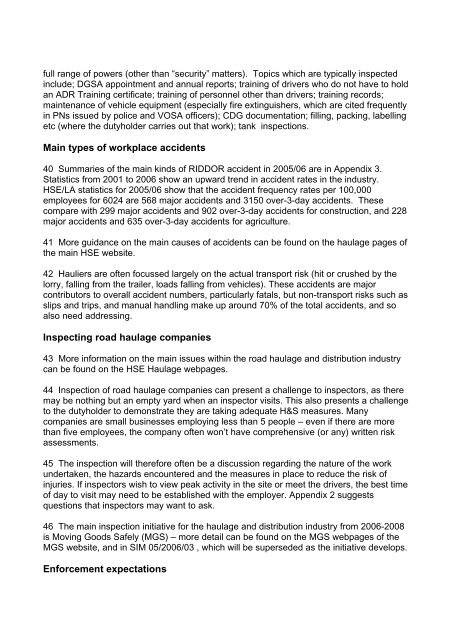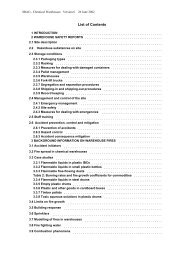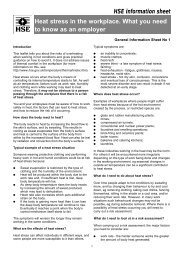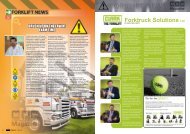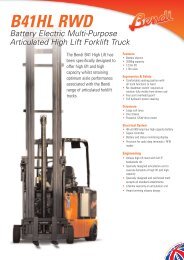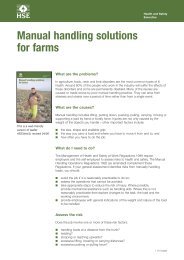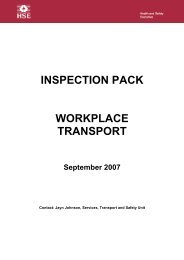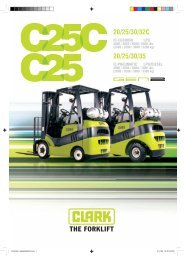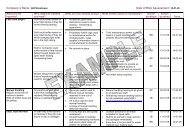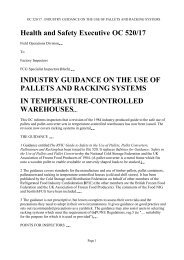The road haulage and distribution industry - overview - Forktruck ...
The road haulage and distribution industry - overview - Forktruck ...
The road haulage and distribution industry - overview - Forktruck ...
You also want an ePaper? Increase the reach of your titles
YUMPU automatically turns print PDFs into web optimized ePapers that Google loves.
full range of powers (other than “security” matters). Topics which are typically inspectedinclude; DGSA appointment <strong>and</strong> annual reports; training of drivers who do not have to holdan ADR Training certificate; training of personnel other than drivers; training records;maintenance of vehicle equipment (especially fire extinguishers, which are cited frequentlyin PNs issued by police <strong>and</strong> VOSA officers); CDG documentation; filling, packing, labellingetc (where the dutyholder carries out that work); tank inspections.Main types of workplace accidents40 Summaries of the main kinds of RIDDOR accident in 2005/06 are in Appendix 3.Statistics from 2001 to 2006 show an upward trend in accident rates in the <strong>industry</strong>.HSE/LA statistics for 2005/06 show that the accident frequency rates per 100,000employees for 6024 are 568 major accidents <strong>and</strong> 3150 over-3-day accidents. <strong>The</strong>secompare with 299 major accidents <strong>and</strong> 902 over-3-day accidents for construction, <strong>and</strong> 228major accidents <strong>and</strong> 635 over-3-day accidents for agriculture.41 More guidance on the main causes of accidents can be found on the <strong>haulage</strong> pages ofthe main HSE website.42 Hauliers are often focussed largely on the actual transport risk (hit or crushed by thelorry, falling from the trailer, loads falling from vehicles). <strong>The</strong>se accidents are majorcontributors to overall accident numbers, particularly fatals, but non-transport risks such asslips <strong>and</strong> trips, <strong>and</strong> manual h<strong>and</strong>ling make up around 70% of the total accidents, <strong>and</strong> soalso need addressing.Inspecting <strong>road</strong> <strong>haulage</strong> companies43 More information on the main issues within the <strong>road</strong> <strong>haulage</strong> <strong>and</strong> <strong>distribution</strong> <strong>industry</strong>can be found on the HSE Haulage webpages.44 Inspection of <strong>road</strong> <strong>haulage</strong> companies can present a challenge to inspectors, as theremay be nothing but an empty yard when an inspector visits. This also presents a challengeto the dutyholder to demonstrate they are taking adequate H&S measures. Manycompanies are small businesses employing less than 5 people – even if there are morethan five employees, the company often won’t have comprehensive (or any) written riskassessments.45 <strong>The</strong> inspection will therefore often be a discussion regarding the nature of the workundertaken, the hazards encountered <strong>and</strong> the measures in place to reduce the risk ofinjuries. If inspectors wish to view peak activity in the site or meet the drivers, the best timeof day to visit may need to be established with the employer. Appendix 2 suggestsquestions that inspectors may want to ask.46 <strong>The</strong> main inspection initiative for the <strong>haulage</strong> <strong>and</strong> <strong>distribution</strong> <strong>industry</strong> from 2006-2008is Moving Goods Safely (MGS) – more detail can be found on the MGS webpages of theMGS website, <strong>and</strong> in SIM 05/2006/03 , which will be superseded as the initiative develops.Enforcement expectations


